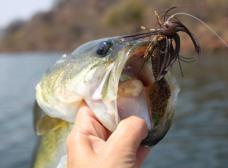Summer ledge fishing
Mokolo dam is a dam which favours ledge fishermen because the majority of the shoreline drops down in a series of ledges, from shallow to deep. What is a ledge, you may ask. A ledge can be defined as an underwater ridge, rock shelf, reef, or line of rocks in a body of water. Bass anglers typically define a ledge as a sharp contour change of 45 degrees or greater.
However, summertime ledges should not be equated with wintertime vertical bluff structures. Although the better summer ledges are rather steep drops, it does not mean these are necessarily big drops. A 6-foot river channel lip is a ledge, as well as a small 1-foot drop along an otherwise uniform flat. When anglers talk about ‘fishing the drop’ or a ‘drop-off’, they are in fact referring to the edge of a ledge.
When bass move from the shallows into deeper water after the spawn they will use the easiest and shortest route they can find.
When they need to feed they will use the same route back toward shallower water. These ‘routes’ don’t move, they are part of the bottom composition of the lake, so season after season, you will find that bass will use them to migrate from one area to the next. At any given time, you may find that the majority of the bass are going to be very near, or somewhere along those migration routes. This is why you always seem to catch more bass along the shoreline in areas that are near deep water.
Ledges are ideal bass highways. They offer depth, for comfort during the summer months, but at the same time, a quick vertical move will have the bass in shallower water without much effort. Ledge fishing is often the key to successful summertime bass fishing.
Just as with shoreline fishing, there are ledges or areas on ledges that tend to produce more fish than other areas. The key to identifying these productive areas is to apply the same rules you would when looking for productive shoreline areas. Structure and cover are the primary factors in finding likely ledge fishing areas, just as they are primary factors in finding likely shoreline fishing areas. Structure, being the bottom composition such as rocks, gravel, mud, etc. and topographical features such as points, cuts, creek junctions, gradual drop-offs, steep drop-offs, etc. and cover, being that which allows the bass protection from light, camouflage and concealment from prey, and physical protection. We all know that bass will orient themselves to cover such as stumps, laydowns, brush piles, vegetation, manmade structure, overhangs, etc. You need to take these two factors (structure and cover) into consideration when searching for productive ledges in order to eliminate a lot of non-productive water, just as you would when applying them to traditional shoreline fishing.
When you think you have found the ideal ledge, position your boat over the deepest water so that you can cast deep-diving crankbaits and bottom-probing lures such as jigs and plastics (Texas-, Carolina, Mojo, or dropshot rigged), toward the shallows. When you hook a fish, make a mental note of the depth you caught it in so that you can start determining the most productive depth. Once you have done this, position the boat at that depth and parallel to the structure.
Cast at different angles so that you can work the bait parallel along the drop-off, at a slight downhill angle or at a slight uphill angle.














0 Comments